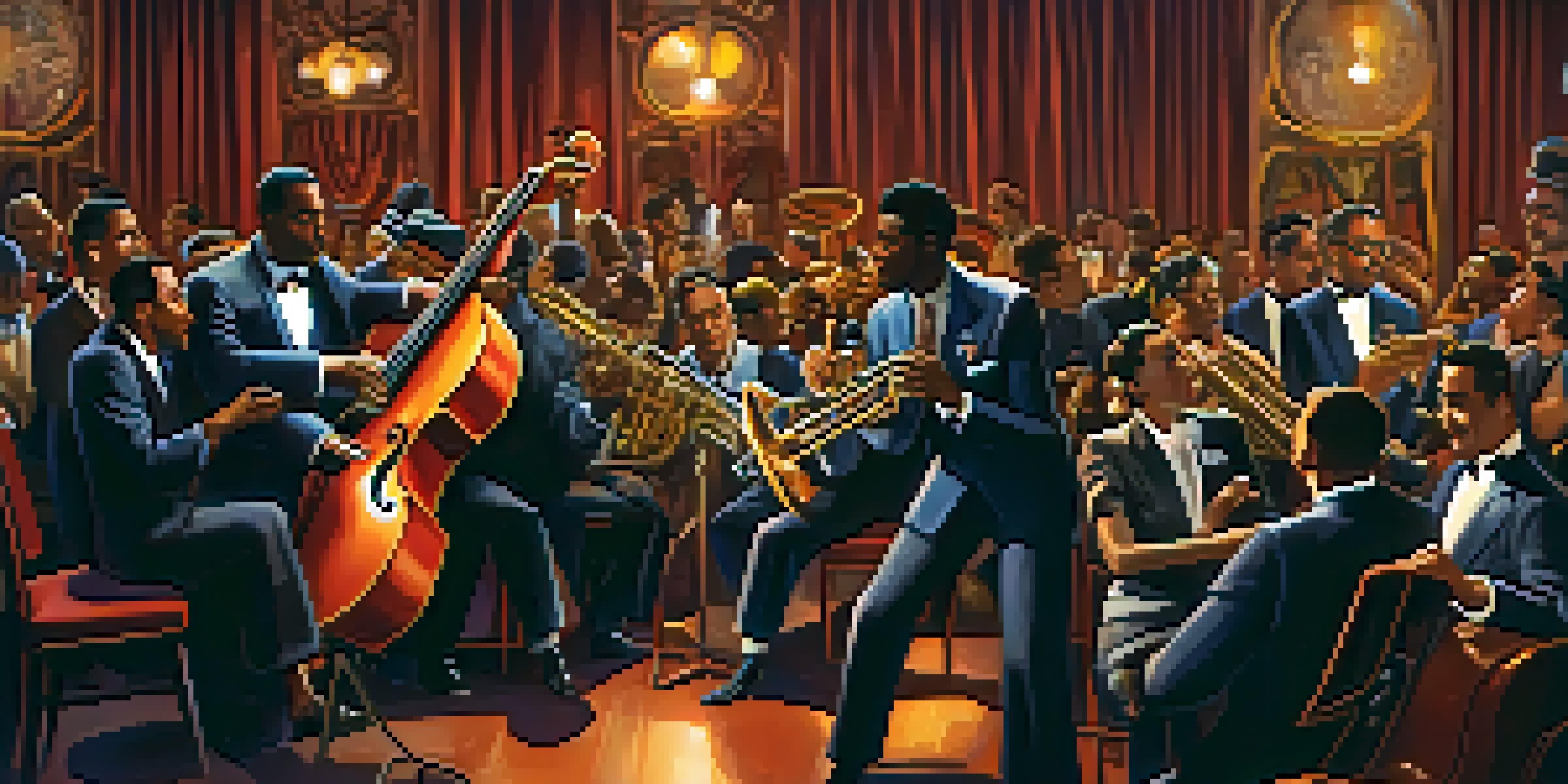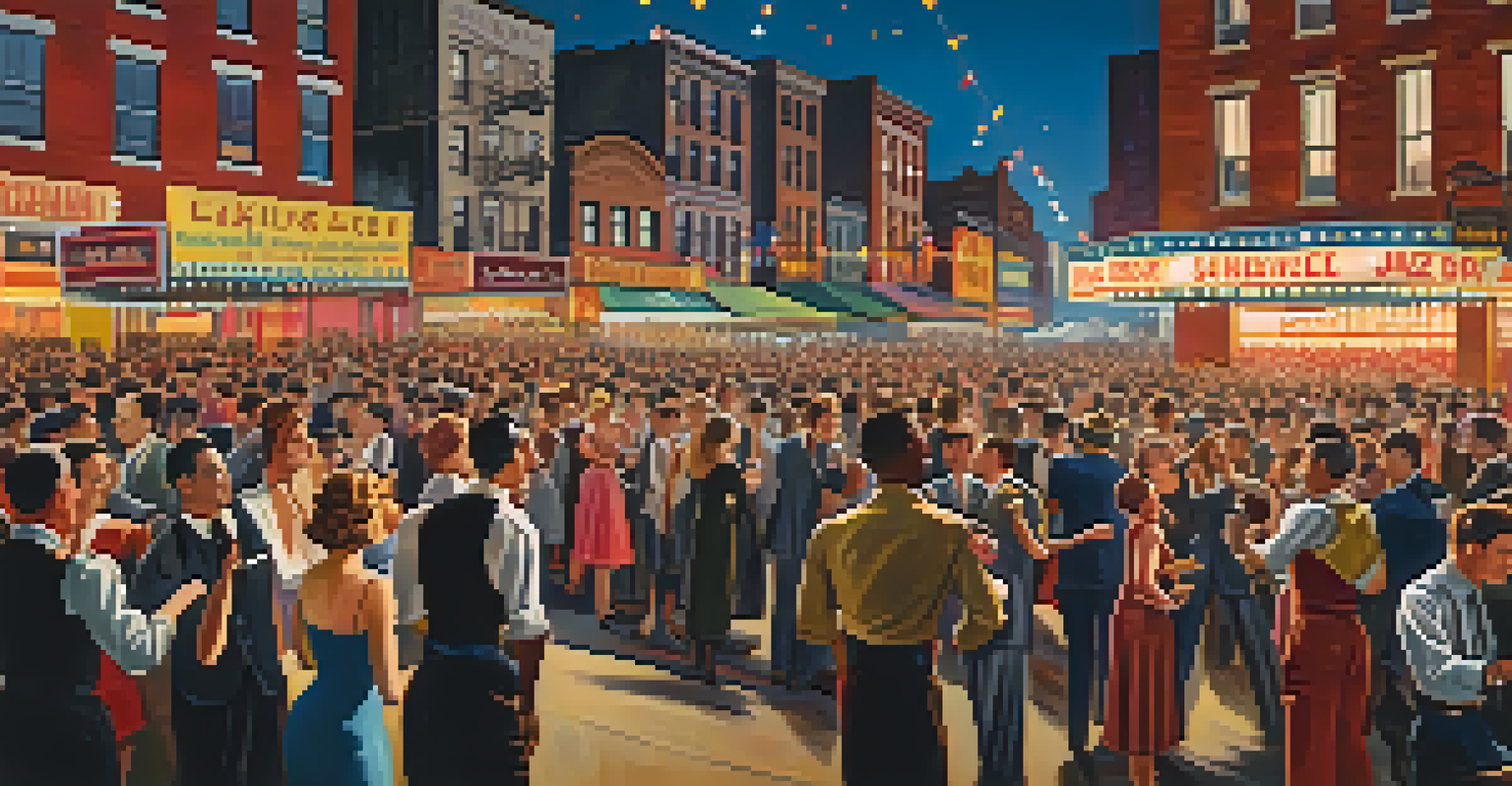From Swing to Bebop: NYC's Jazz Transformation in the 40s

The Rise of Swing: A Precursor to Change
In the late 1930s, swing music dominated the jazz scene, captivating audiences with its lively beats and syncopated rhythms. Big bands led by icons like Duke Ellington and Count Basie filled dance halls, bringing people together in celebration. This era was all about the dance floor, where the music was designed to get people moving and connecting with one another.
Jazz is not just music, it's a lifestyle, a way of expressing oneself that transcends boundaries.
As the 40s approached, swing's popularity began to evolve, and many musicians felt a creative itch for something deeper and more expressive. While swing laid the foundation, a new wave of jazz was brewing just beneath the surface. Musicians started to experiment with complex harmonies and intricate melodies, seeking to push the boundaries of the genre.
Swing was not just a musical style; it reflected the cultural zeitgeist of the time, encapsulating the joy and optimism of a nation on the brink of war. Yet, the seeds of change were being sown, setting the stage for a transformative period in jazz history that would soon unfold.
Bebop Emerges: The Shift in Jazz Philosophy
By the early 1940s, bebop began to emerge as a reaction against the constraints of swing. Musicians like Charlie Parker and Dizzy Gillespie sought to create a more intricate and improvisational style that emphasized individual expression over mass appeal. This new approach allowed for greater freedom in melody and rhythm, transforming jazz into an art form that demanded active listening.

Unlike swing, which often featured orchestras playing arranged pieces, bebop focused on smaller combos, allowing musicians to showcase their improvisational skills. This shift created an intimate atmosphere where artists could engage in a musical conversation, each taking turns to express their creativity. It was a radical departure that spoke to the changing cultural landscape of New York City.
Swing Music Set the Stage for Change
In the late 1930s, swing music captivated audiences and laid the groundwork for a more expressive jazz movement.
Bebop wasn't just about music; it represented a broader cultural movement that embraced innovation and experimentation. This new style resonated with the youth and artists of the time, who were looking for ways to break free from traditional norms and express their individuality.
Key Figures: Pioneers of Bebop
Among the pivotal figures in the bebop movement was Charlie Parker, whose virtuosic saxophone playing and innovative compositions changed the course of jazz. Parker's ability to weave complex melodies with rapid-fire improvisation set a new standard for musicians everywhere. His iconic tunes, like 'Ornithology,' are still celebrated in jazz circles today.
Bebop is a reflection of the times, an art form that demands engagement and deep listening.
Dizzy Gillespie, another key figure, brought a unique flair to bebop with his trumpet playing and playful stage presence. He was known for his signature bent trumpet and upbeat personality, which made him a favorite among both musicians and audiences. Together, Parker and Gillespie pushed the boundaries of jazz, opening doors for future generations.
These pioneers were not just musicians; they were visionaries who redefined the sound and spirit of jazz. Their contributions laid the groundwork for the evolution of jazz in the following decades, influencing countless artists and styles that would emerge in the years to come.
The Cultural Impact of Bebop in NYC
Bebop emerged in the vibrant nightlife of New York City, particularly in venues like Minton's Playhouse and the Five Spot Café. These clubs became incubators for innovation, where musicians could experiment and collaborate in front of live audiences. The rich cultural tapestry of Harlem provided the perfect backdrop for this new sound to flourish.
As bebop gained traction, it began to attract a diverse audience, including artists, intellectuals, and everyday jazz lovers. This new appreciation for the complexity of jazz reflected broader societal changes, as people sought deeper connections through art and music. The rise of bebop marked a turning point in how jazz was perceived—no longer just dance music, but a serious and sophisticated art form.
Bebop Redefined Jazz Expression
Bebop emerged in the 1940s as a reaction to swing, emphasizing individual creativity and complex improvisation.
The influence of bebop extended beyond the music scene; it also inspired visual artists and writers who were drawn to its improvisational nature and expressive power. The cross-pollination of creative ideas during this era enriched the cultural landscape of New York City, making it a hub for artistic innovation.
Bebop's Musical Characteristics: A Deep Dive
One of the defining characteristics of bebop is its emphasis on complex chord progressions and intricate melodies. Unlike swing, which often relied on simpler structures, bebop challenged musicians to master advanced harmonies and rapid tempos. This complexity required a high level of skill and understanding, pushing musicians to elevate their craft.
Improvisation became the cornerstone of bebop, with musicians often engaging in spontaneous, intricate solos that showcased their individuality. This focus on improvisational dialogue allowed for a dynamic exchange of ideas, where each artist built upon the contributions of others. It transformed the performance experience into a collaborative art form.
Bebop also introduced new rhythms and tempos that challenged conventional notions of swing. With its fast-paced, syncopated beats, bebop demanded active listening and encouraged audiences to engage intellectually with the music. This shift in rhythm and structure further solidified bebop's identity as a progressive and revolutionary movement within jazz.
The Legacy of Bebop: Influencing Future Generations
The legacy of bebop is profound, as it laid the groundwork for numerous jazz styles that followed, including hard bop, modal jazz, and free jazz. Musicians who came of age in the bebop era carried its innovations into their own works, further expanding the possibilities of jazz music. Artists like Miles Davis and John Coltrane drew inspiration from the bebop pioneers, each adding their unique voice to the genre.
Bebop's influence extends beyond the realm of jazz; it permeated popular music, shaping the sound of rock 'n' roll and beyond. Elements of bebop can be heard in various musical genres, as its improvisational spirit and complex harmonies inspired countless artists seeking to break free from traditional structures.
Legacy of Bebop Influences All Music
The innovations of bebop laid the foundation for future jazz styles and impacted a wide range of musical genres beyond jazz.
Today, bebop remains a cornerstone of jazz education, with aspiring musicians studying its techniques to develop their own styles. The impact of this vibrant era continues to resonate, reminding us of the creativity and innovation that jazz embodies—a dynamic art form that evolves while honoring its rich history.
Conclusion: NYC's Jazz Transformation in the 40s
The transformation of jazz in New York City during the 1940s represents a pivotal moment in music history. From the lively dance halls of swing to the intricate improvisations of bebop, this era showcased the dynamic evolution of jazz as an art form. The artists who emerged during this time not only redefined what jazz could be but also paved the way for future generations.
As we reflect on the vibrant culture of 1940s NYC, it's clear that the city played a crucial role in shaping the sound and spirit of jazz. The creative energy found in clubs and neighborhoods fostered an environment where innovation thrived, allowing musicians to explore new horizons. This period stands as a testament to the power of artistic expression in times of change.

Ultimately, the legacy of this jazz transformation is felt not just in music but also in the cultural identity of New York City itself. The sounds of bebop continue to inspire, reminding us of the enduring nature of creativity and the ever-evolving landscape of jazz.